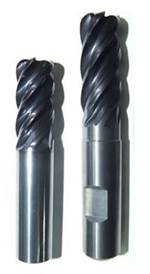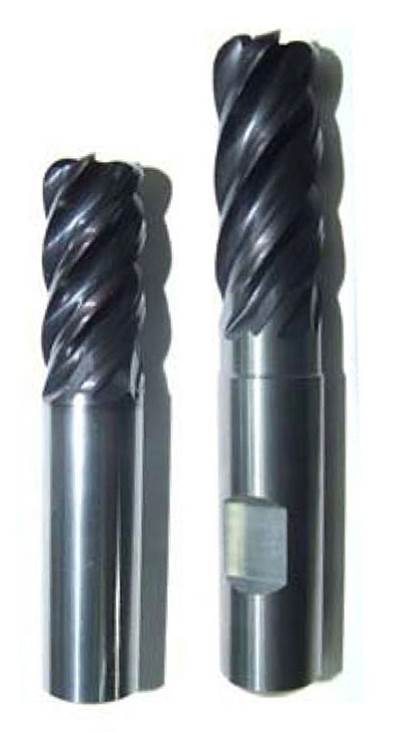Carbide Endmills Cut Leadtimes
Moldmaker quadruples throughput in hardened stainless with advanced solid carbide endmills.
It's not what you pay for tooling, but how many parts the tools make per day that counts. That's the lesson of a busy moldmaker who mills precise details in stainless steel hardened to 62 Rc. By replacing ordinary carbide cutters with premium solid carbide endmills, Tobin Tool and Die (Northfield, NH) produced a difficult set of molds in one-quarter of the time. CoroMill Plura solid carbide endmills from Sandvik Coromant generated savings in shop time worth around $250,000 during a year. The shop also realized up to four times the tool life to offset the higher cost of the new cutters. "In terms of the cost of the endmills, it's a wash," explains Ralph Gove, Tobin's injection mold cell leader. "We were using one of the new Sandvik cutters versus three or four of the other brand. The real point is that spending a little more per cutter saved us lots of time."
Tobin Tool and Die makes small compression and injection molds almost exclusively for the automobile industry. To achieve tight tolerances without costly electrical discharge machining (EDM) or grinding, the company machines many of the molds in hardened 4140 or P20 tool steel. However, one especially demanding job included precise cuts in 440 stainless steel pre-hardened to 58 to 62 Rc. According to Gove, "The plastic molding market is getting tougher and tougher as far as tolerancing goes. In the past, we milled in the soft condition and accepted the distortion and expense of grinding that came with heat treating. Now, customers want better tools for less money. Milling in the hardened condition gives us a solution."
Conventional Carbide
Tobin Tool routinely produces a family of compression molds used to make bonded piston seals. The stainless steel molds are seven to 11 inches in diameter and two inches high, finish-turned within 0.005 inch flatness and parallelism. Specifications require air vents cut in the mold face and outside diameter to be accurate within 0.0008 in. The half-moon face vents and arc-shaped O.D. vents are 0.4 in. wide by 1 to 1.8 in. long and 0.04 to 0.06 in. deep. "Those vents are critical," observes Gove. "How much air they vent out of the cavity controls how much rubber flows into the mold."
A Mori Seiki vertical machining center mills the vents with a helical toolpath. Gove notes that, "Fifteen years ago, we'd have EDM'd a hardened part like that. Now with the price of graphite quadrupled, the cost of EDM'ing would be prohibitive."
While milling the vents to precise tolerances in hardened stainless saved the time of heat treating and possibly re-machining, it posed special challenges for endmills. The first batch of 22 molds was milled with common solid carbide endmills coated with titanium nitride. The initial production lot required nearly 44 hours to complete, and each mold wore out two double-ended cutters. "With the old tools, it took us up to two hours to do one part, and we used two endmills on both ends," recalls Gove.
Advanced Carbide
To recover valuable machining time, Tobin Tool engineers tried new CoroMill Plura solid carbide cutters from Sandvik Coromant (Fair Lawn, NJ). Sandvik field representative Pete Samuelson had previously introduced the advanced cutters on a prototype mold shoe cut in tool steel hardened to 44 Rc. In place of conventional solid carbide tools, the CoroMill Plura endmills finished a 16-hour milling job in about eight hours. "That's the kind of job CoroMill Plura endmills were designed for," notes Samuelson.
Sandvik Coromant formulated Grade GC1010 for its CoroMill Plura endmills specifically for stainless steel and hardened materials up to 63 Rc. A heat-resistant titanium aluminum nitride coating protects the fine-grained carbide substrate. Samuelson explains, "Together, the hardness of the micrograin structure and the heat resistance of the TiAlN coating give you higher cutting speeds and/or longer tool life."
The geometry of the CoroMill Plura endmills also is optimized for hard-part machining. CoroMill Plura cutters come in diameters down to 0.4 mm (0.016 in.) with a large ratio of central core to overall diameter. The high core-to-diameter ratio maximizes rigidity and minimizes deflection in hard-part milling. Unlike standard endmills optimized for soft steel, the CoroMill Plura endmill also has negative-rake cutting edges reinforced to better withstand the heavy machining stresses of hard materials.
For the compression molds, Tobin Tool machinists used 6 mm diameter, three-flute cutters to mill the half-moon face vents. The arc-shaped O.D. vents were cut with 10 mm diameter, 10-flute cutters. The advanced carbide cutters enabled the moldmaker to increase cutting speeds dramatically. For example, milling speed on the O.D. of the compression mold was 125 to 175 sfpm with the original solid carbide tools, but closer to 450 to 525 sfpm with the new endmills. "The CoroMill Plura cutters performed just beautifully," says Gove.
Faster and Longer
The effect on cycle time was dramatic. Depending on the size of the mold, cutting time fell from two hours to just 30 minutes per piece. A 22-piece batch of seven-inch molds was done in 12 hours - 73 percent faster than possible with the original solid cutters. At $80 per shop hour, the faster throughput with the new tools is worth around $250,000 annually.
Higher cutting speeds and lower cutting forces also improved the quality of some of the vents. Gove notes that, "The half-moon on the face is now 100 percent better. There was an awful lot of difference."
Significantly, the new single-ended carbide cutters outlasted the old double-ended tools despite their higher speeds. Each CoroMill Plura cutter typically gives Tobin machinists two to 2.5 pieces of a seven-inch diameter or one to 1.5 pieces of an 11-inch diameter.
Together, higher throughput and longer tool life to end frequent tool changes provided Tobin Tool & Die with a productive solution to a hard-part machining problem.
Related Content
The Ins and Outs of Hot Runner Temperature Control
A training checklist that explains the why and how of proper hot runner temperature control and system management.
Read More6 Ways to Optimize High-Feed Milling
High-feed milling can significantly outweigh potential reliability challenges. Consider these six strategies in order to make high-feed milling successful for your business.
Read MoreRevisiting Some Hot Runner Fundamentals
What exactly does a hot runner do? If you’ve been in the injection molding industry for any length of time, you might think the answer is obvious, but it is not.
Read MoreSolving Mold Alignment Problems with the Right Alignment Lock
Correct alignment lock selection can reduce maintenance costs and molding downtime, as well as increase part quality over the mold’s entire life.
Read MoreRead Next
End Mills Feature High Performance, Long Tool Life
Designed to replace multiple tools used for roughing, semi-finishing, slotting and profiling, Hanita’s VariMill II family of solid-carbide end mills is suited for high-temperature alloys, nickel- and carbon-based alloys and titanium. Available from Kennametal, the tools feature five unequally spaced flutes, a patented flute form and end geometry and AlTiN coating that enables heavy cuts and long tool life, the company says. The end mill geometries are designed to virtually eliminate chatter and harmonics to allow slotting at cutting depths of 1 × D and perform side-milling operations at redial and axial cutting depths ranging to 0.
Read MoreHow to Use Continuing Education to Remain Competitive in Moldmaking
Continued training helps moldmakers make tooling decisions and properly use the latest cutting tool to efficiently machine high-quality molds.
Read MoreReasons to Use Fiber Lasers for Mold Cleaning
Fiber lasers offer a simplicity, speed, control and portability, minimizing mold cleaning risks.
Read More






.png;maxWidth=300;quality=90)


















